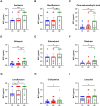Diversity of glpK Gene and Its Effect on Drug Sensitivity in Mycobacterium bovis
- PMID: 35401008
- PMCID: PMC8986483
- DOI: 10.2147/IDR.S346724
Diversity of glpK Gene and Its Effect on Drug Sensitivity in Mycobacterium bovis
Abstract
Background: Glycerol kinase (glpK) is essential for the first step of glycerol catabolism in Mycobacterium tuberculosis. However, Mycobacterium bovis has been known to grow poorly in glycerol media because of a base insertion in the glpK gene.
Methods: We analyzed the glpK gene sequences of 60 clinical M. bovis isolates, and determined the minimum inhibitory concentration of 14 drugs by microdilution method to evaluate the effect of frameshift mutations on drug sensitivity. The effect of M. bovis growth rate on its drug sensitivity was investigated using bacteria grown on glycerol or pyruvate.
Results: A total of 44 (73.33%) clinical M. bovis isolates have frameshift mutations in a homopolymeric tract of 7 cytosines in the glpK gene. 15.00% M. bovis isolates showed phenotypic drug resistance. Glycerol metabolism-deficient M. bovis showed reduced susceptibility to 9 out of 14 tested drugs. Mutations in the glpK gene can lead to impaired growth in glycerol-based media, while the minimal inhibitory concentration values of slow-growing M. bovis were higher.
Conclusion: Mutations in the glpK gene can lead to slowed growth and reduced susceptibility to drugs in M. bovis, which may contribute to the emergence of drug-resistant M. bovis and pose a threat to human health owing to the zoonotic capacity of M. bovis.
Keywords: Mycobacterium bovis; drug resistance; glpK; tuberculosis.
© 2022 Dong et al.
Conflict of interest statement
The authors report no conflicts of interest in this work.
Figures


Similar articles
-
Common Variants in the Glycerol Kinase Gene Reduce Tuberculosis Drug Efficacy.mBio. 2019 Jul 30;10(4):e00663-19. doi: 10.1128/mBio.00663-19. mBio. 2019. PMID: 31363023 Free PMC article.
-
Phase variation in Mycobacterium tuberculosis glpK produces transiently heritable drug tolerance.Proc Natl Acad Sci U S A. 2019 Sep 24;116(39):19665-19674. doi: 10.1073/pnas.1907631116. Epub 2019 Sep 5. Proc Natl Acad Sci U S A. 2019. PMID: 31488707 Free PMC article.
-
The pyruvate requirement of some members of the Mycobacterium tuberculosis complex is due to an inactive pyruvate kinase: implications for in vivo growth.Mol Microbiol. 2005 Apr;56(1):163-74. doi: 10.1111/j.1365-2958.2005.04524.x. Mol Microbiol. 2005. PMID: 15773987
-
Drug susceptibility of Spanish Mycobacterium tuberculosis complex isolates from animals.Tuberculosis (Edinb). 2007 Nov;87(6):565-71. doi: 10.1016/j.tube.2007.08.004. Epub 2007 Sep 27. Tuberculosis (Edinb). 2007. PMID: 17900988
-
Human Mycobacterium bovis infection in the United Kingdom: Incidence, risks, control measures and review of the zoonotic aspects of bovine tuberculosis.Tuberculosis (Edinb). 2006 Mar;86(2):77-109. doi: 10.1016/j.tube.2005.05.002. Epub 2005 Oct 28. Tuberculosis (Edinb). 2006. PMID: 16257579 Review.
Cited by
-
Genomic Insight into Primary Adaptation of Mycobacterium tuberculosis to Aroylhydrazones and Nitrofuroylamides In Vitro.Antibiotics (Basel). 2025 Feb 22;14(3):225. doi: 10.3390/antibiotics14030225. Antibiotics (Basel). 2025. PMID: 40149037 Free PMC article.
-
Mycobacterium bovis frd operon phase variation hijacks succinate signaling to drive immunometabolic rewiring and pathogenicity.Nat Commun. 2025 Jul 16;16(1):6538. doi: 10.1038/s41467-025-61824-9. Nat Commun. 2025. PMID: 40664698 Free PMC article.
-
Citric acid impairs type B trichothecene biosynthesis of Fusarium graminearum but enhances its growth and pigment biosynthesis: transcriptomic and proteomic analyses.Appl Environ Microbiol. 2025 Jun 18;91(6):e0153124. doi: 10.1128/aem.01531-24. Epub 2025 May 14. Appl Environ Microbiol. 2025. PMID: 40366181 Free PMC article.
-
Rv0687 a Putative Short-Chain Dehydrogenase Is Required for In Vitro and In Vivo Survival of Mycobacterium tuberculosis.Int J Mol Sci. 2024 Jul 18;25(14):7862. doi: 10.3390/ijms25147862. Int J Mol Sci. 2024. PMID: 39063103 Free PMC article.
-
Novel mechanisms of macrolide resistance revealed by in vitro selection and genome analysis in Mycoplasma pneumoniae.Front Cell Infect Microbiol. 2023 May 22;13:1186017. doi: 10.3389/fcimb.2023.1186017. eCollection 2023. Front Cell Infect Microbiol. 2023. PMID: 37284499 Free PMC article.
References
-
- World Health Organization. Global Tuberculosis Report 2021. Geneva: World Health Organization; 2021.
LinkOut - more resources
Full Text Sources

